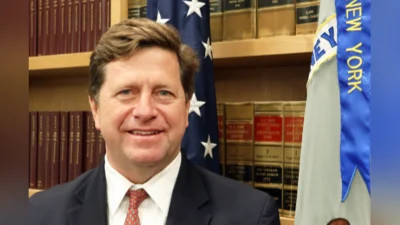On June 22, the U.S. Department of Transportation (U.S. DOT) Volpe National Transportation Systems Center (Volpe Center) welcomed Dr. Erin Mayfield of Princeton University to its 2021 thought leadership speaker series, Innovation for a Sustainable, Equitable Transportation System.
Dr. Mayfield is a sustainable systems engineering and public policy researcher and postdoctoral scholar at Princeton’s Andlinger Center for Energy and the Environment and the High Meadows Environmental Institute. She presented her talk, "Net-Zero America: Potential Pathways, Infrastructure, and Impacts,” in advance of the July 2021 release of Net-Zero America’s final report on a two-year study of domestic energy supply transition. The session was hosted by U.S. DOT Volpe Center Director Anne D. Aylward.
This post provides a recap of Dr. Mayfield’s talk. You can watch highlights from the event here.
Modeling Affordable and Transformational Decarbonization Scenarios
While policymakers discuss high-level domestic and global imperatives to reduce carbon emissions, researchers like Dr. Mayfield and the Net-Zero America team are leveraging a multi-disciplinary approach to modeling “least cost” alternative techno-economic pathways to emissions targets by 2050.
Rooted in a framework of six pillars of decarbonization, the Net-Zero America investigation considered five scenarios; the study is unique in its examination of the broad contours of domestic energy supply transformation as well as the details regarding planning and investment decision-making. The modeling tactic produces a more geographic and temporal granularity than prior studies.
The research highlighted that transitioning to net-zero by 2050 will require significant mobilization of capital, and an up-front investment of more than $3 trillion in the 2020s alone—more than double the study team’s “no new policies” reference case.
Sustainable and Equitable Pathways Can Spur Job Creation and Transform the Domestic Workforce
The research process emphasized transformational shifts in domestic energy supply, including significant transitions from fossil fuels to renewable sources of energy for both industrial and residential applications, electrification of our multimodal transportation network including electric vehicles, and improved efficiencies in meeting the energy needs of buildings and structures. All the pathways to transition to net-zero emissions, Mayfield presented, will spark transformations in capital mobilization, physical infrastructure, the energy workforce, air pollution, and public health.
Dr. Mayfield’s data was mapped and modeled at national, state, and, in some cases, county-level scales, producing scenarios that quantified the effects of net-zero energy by 2050 on our labor force while taking into consideration training and workforce development, population shifts, land use patterns and development requirements, and dozens of other factors and sensitivities. Across the five scenarios described in the Net-Zero America report, all result in direct job creation, with the most transformational scenarios resulting in 8 million energy sector jobs and an expansion in the share of the U.S. labor force employed in the energy sector from 1.5 percent in 2018 to 4 percent in 2050—a staggering rise.
Notably, Dr. Mayfield stressed the importance of a balanced transformation that acknowledges the heterogeneity of potential workforce and economic benefits. While all scenarios resulted in national net increases in energy jobs, there will be early declines in regions that are fossil fuel industry strongholds. She noted, “It is important to help facilitate an equitable and just transition…to deliver on the transitions.”
"The rate of decarbonization is influenced by the... availability of labor with the requisite experience, skills, and education."
-Dr. Erin Mayfield, Princeton University
Co-benefits, Tradeoffs, and Impacts
The Net-Zero America analysis is not predictive; rather, the models produce scenarios that can be compared against one another and against a “no new policies” or status quo scenario. This allows policymakers to weigh a range of trade-offs and “co-benefits,” which are indirect positive impacts.
Each of the five scenarios reveals significant co-benefits to air quality and public health. For example, decarbonization, the researchers found, can avoid more than 100,000 premature mortalities by 2050 through pollution reduction.
Dr. Mayfield’s work depicts the range of possibilities for meeting net-zero energy objectives while positively impacting employment and labor force participation. She notes that while policymakers have not reached consensus on a specific pathway, current legislative proposals reflect a magnitude of investment—and investment in the categories of energy generation—that is consistent with a commitment to net-zero goals over at least the next 10 years.
Net-Zero America’s findings, including a web portal with downloadable data sets, can be found at NetZeroAmerica.Princeton.edu.
View highlights from Dr. Mayfield’s June 22, 2021 talk here. To learn more about the U.S. DOT Volpe Center’s 2021 thought leadership program, please contact U.S. DOT Volpe Center Director of Strategic Initiatives for Research and Innovation Ellen E. Bell.
Original source can be found here.





